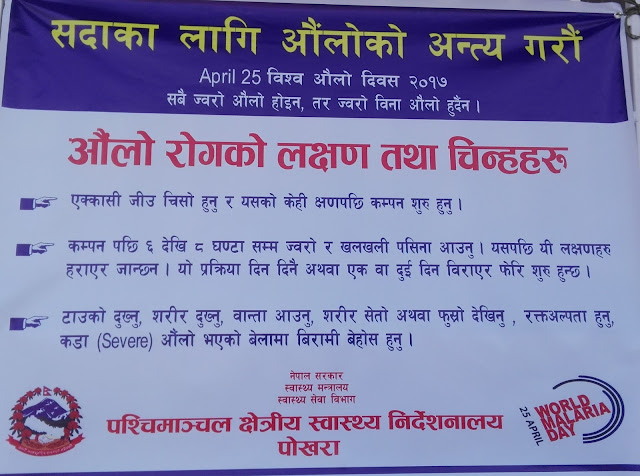In 1958, national malaria eradication program was launched with the objective of eradicating malaria from the country. Due to various reasons the eradication concept reverted to control program in 1978. Following the call of WHO to revamp the malaria control programs in 1998, Roll Back Malaria (RBM) initiative was launched to control malaria transmission in hard‐core forests, foot‐hills, inner‐Terai and hill river valleys, which accounted for more than 70 % of the total malaria cases in the country. The high risk of acquiring the disease is attributed to the abundance of vector mosquitoes, mobile and vulnerable population, relative inaccessibility of the area, suitable temperature, environmental and socio‐economic factors. The recent micro‐stratification, based on number of malaria cases, geo‐ecology, vector breeding and vulnerability due to migration and population movements, further narrowed down the essentials to VDC level risks as compared to earlier district as units of risks. It has clearly shown that only 54 VDC’s are at high risk, 201 VDC’s at moderate risk and 999 VDC’s at low risk. Based on the micro‐stratification report 2013, approximately 13.02 million population (47.9%) live in malaria endemic areas (VDCS); out of which ~1 million (3.62%) live in high risk VDCs, 2.66 million (9.8%) live in moderate risk VDCs, and 9.38 million(34.52%) live in low risk VDCs. A total population of 14.13 (52.1%) is estimated to live in VDCs where there is no malaria transmission. The high risk areas consist of foothills with river belts, forest fringe areas in terai, hill river valleys, inner terai areas. Low risk VDCs lie in plain cultivated outer Terai, mountain, and valleys in the mountains.
- To sustain zero death due to malaria from 2012 onwards;
- To reduce the incidence of indigenous malaria cases by 90% by 2018 (relative to 2012);
- To reduce no. of VDCs having indigenous malaria cases by 70% by 2018 (relative to 2012);
- To receive WHO certification of malaria free status by 2025.
- By the end of 2015, ward‐wise malaria risk micro‐stratification will be, so the intervention units could be wards in place of current VDC’s and earlier districts.
Development and roll over of SMS and web based recording and reporting system for strengthening malaria surveillance, including suspected and confirmed cases reporting.
- Introduction of Case based surveillance in all districts by the end of 2014.
- All malaria cases will be recorded and reported through SMS and Web‐based MDIS by the end of 2015.
- Establishment and expansion of Border check posts: 2 in 2014, 2 in 2015 and 3 in 2016 and continued thereafter.
Quarterly review of the recorded data and plan interventions accordingly
- Three quarterly reviews will be conducted and validation of data completed by the
- end of each year.
Foci investigation rolled out by the end of 2014
- At least 54 foci will be investigated in 2014, 160 in 2015 and 100 each year after.
- Investigated foci will be eliminated gradually and by the end of 2016 a total of 214
- foci will be eliminated, sustained thereafter and gradually increased as per above
- target.
Number of operational research will be carried out generating evidence for policy making.
Prevention using LLIN: Coverage of high risk VDC population through mass campaign and pregnant women in high and moderate risk VDCs through ANC visits.
- 471,747 LLINs in 2014; 149,969 LLINs in 2015; 252,440 LLINs in 2016; 491,112 LLINs
- in 2017 and 155,851 LLINs in 2018.
- 88,444 households in 2014; 60,000 households in 2015 and 30,000 households in 2016.
- Foci elimination and documentation of lessons learnt for prospective activities.
- 54 in 2014; 160 in 2015 and 100 every year thereafter.
Development of training package on malaria case management: development and roll out by 2015
Training on case management of malaria by 2015
- FCHVs in remote VDCs to detect malaria using RDTs,
- Training on malaria case management for public & private sector health care providers
Expand and improve quality of malaria microscopy service‐continued annually
- Finalize and roll over of the SOP on malaria microscopy
- Establish slide banks for training and reference in malaria microscopy
- Conduct internal competency assessment of malaria lab technicians and assistant
- Conduct external competency assessment lab technicians and assistants
- Conduct instructional skills development training for trainers in malaria microscopy
- Basic and refresher training in microscopy
- training in malaria microscopy
- Training on preventive maintenance of microscopes
- Supportive supervision and monitoring of malaria microscopists
- Cross‐checking / validation of blood smears
- Regular monthly recording and reporting through FMIS/MDIS.
- Annual health facility survey conducted to document no stock out of logistics.
- Develop communication package to mobilize communities for malaria prevention
- Commemorate World Malaria Day: April 25.
- Cross–border collaboration meetings annually for sharing the information and harmonizing interventions.
- Training key program staffs in malariology, case management, entomology, health informatics, GIS mapping , malaria microscopy etc.‐ annual targets in annex‐ budget sheet
- Convene Malaria Technical Working Group; at least 3/yr
- Periodically update the national malaria strategic plan: by the end of 2018, review and revise as necessary
- Supervision, monitoring and evaluation: Annually as per M & E Plan.
- Strengthen VBDRTC capacity in malaria training and research: Equipment provided and staffs deployed as necessary
- Recruit and fill vacant positions at EDCD, VBDRTC, Regions and Districts: By the end of 2014, vacant positions will be filled and sustained there after
- Strengthen partnership with WHO and other national/international institutions: Collaborative meetings, activities implemented



